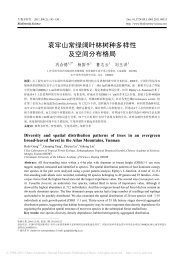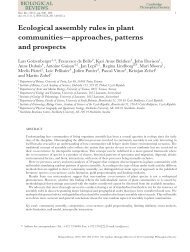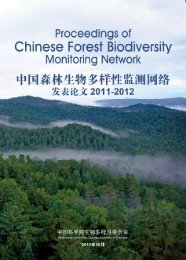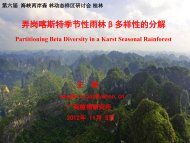the maintenance of species-richness in plant communities
the maintenance of species-richness in plant communities
the maintenance of species-richness in plant communities
You also want an ePaper? Increase the reach of your titles
YUMPU automatically turns print PDFs into web optimized ePapers that Google loves.
Ma<strong>in</strong>tenance <strong>of</strong> <strong>species</strong>-<strong>richness</strong> <strong>in</strong> <strong>plant</strong> <strong>communities</strong><br />
I33<br />
niches are not a general feature <strong>of</strong> vegetation. In fact most ecologists f<strong>in</strong>d that <strong>the</strong>y are,<br />
whe<strong>the</strong>r <strong>the</strong>y are work<strong>in</strong>g <strong>in</strong> <strong>the</strong> deciduous forests, grasslands or weed <strong>communities</strong> <strong>of</strong><br />
Europe (Ellenberg, 1954, 1963 ; Duchaufour, 1960), <strong>the</strong> conifer forests and steppes <strong>of</strong><br />
<strong>the</strong> western United States (Daubenmire, 1968 b, 1970), <strong>the</strong> forests <strong>of</strong> eastern Australia<br />
(Webb, Tracey, Williams & Lance, 1970) or those on tropical mounta<strong>in</strong>s (Wade &<br />
McVean, 1969; Grubb & Stevens, 1976; Grubb & Tanner, 1976). This group<strong>in</strong>g <strong>of</strong><br />
<strong>species</strong> <strong>in</strong> habitat niches is very <strong>of</strong>ten accompanied by a strik<strong>in</strong>g conformation <strong>in</strong><br />
life-form, leaf-form, etc., and clearly many physiological characteristics <strong>in</strong> <strong>the</strong><br />
vegetative adult are similar <strong>in</strong> all <strong>the</strong> <strong>species</strong> with<strong>in</strong> each group. Just why <strong>the</strong> <strong>species</strong><br />
<strong>in</strong>volved should have ‘partitioned’ <strong>the</strong> physical environment <strong>in</strong>to just so many<br />
sections and not more is a very deep question, e.g. why are <strong>the</strong>re four ma<strong>in</strong> forest<br />
formations on most high tropical mounta<strong>in</strong>s and not two or six or twenty? Presumably<br />
patterns <strong>of</strong> vegetational history are partly <strong>in</strong>volved here. With<strong>in</strong> most habitat-groups<br />
<strong>of</strong> <strong>species</strong> differentiation <strong>in</strong> <strong>the</strong> regeneration niche is almost certa<strong>in</strong>ly considerable.<br />
Emphasis on <strong>the</strong> regeneration niche is also relevant to <strong>the</strong> many ord<strong>in</strong>ation studies<br />
made on vegetation <strong>in</strong> <strong>the</strong> last decade. Some <strong>of</strong> <strong>the</strong> axes <strong>of</strong> variation detected are<br />
bound to reflect regeneration characteristics ra<strong>the</strong>r than <strong>the</strong> features <strong>of</strong> <strong>the</strong> physical<br />
environment that those who ord<strong>in</strong>ate usually seek to identify; <strong>in</strong> <strong>the</strong> case <strong>of</strong> <strong>the</strong><br />
tropical ra<strong>in</strong>-forest on one <strong>of</strong> <strong>the</strong> Solomon Islands some <strong>of</strong> <strong>the</strong> variation first found by<br />
an ord<strong>in</strong>ation analysis (Greig-Smith, Aust<strong>in</strong> & Whitmore, 1967) is now known to<br />
reflect vegetation history (Whitmore, 1974).<br />
The conclusion that <strong>species</strong> diversity has more to do with requirements for regeneration<br />
than with partition<strong>in</strong>g <strong>of</strong> <strong>the</strong> habitat niche <strong>of</strong> <strong>the</strong> adult fits well with <strong>the</strong> grow<strong>in</strong>g<br />
conviction <strong>of</strong> some evolutionists, e.g. Grant (1949), Stebb<strong>in</strong>s (1951, 1970, 1g71),<br />
Baker (1959, 1963, 1970) and van der Pijl(1960, 1961), that speciation and ultimately<br />
<strong>the</strong> differentiation <strong>of</strong> genera and families <strong>of</strong> <strong>plant</strong>s have primarily to do with adaptive<br />
changes <strong>in</strong> reproductive characteristics, even though <strong>the</strong>re are still many characters <strong>of</strong><br />
taxonomic importance that are hard to expla<strong>in</strong> functionally (Ehrendorfer, I 973). It<br />
seems that at all taxonomic levels evolutionary divergence may concern any aspect <strong>of</strong> <strong>the</strong><br />
niche. Thus several families have evolved <strong>in</strong> certa<strong>in</strong> narrow and well-def<strong>in</strong>ed habitat<br />
niches, while o<strong>the</strong>rs have tremendously wide ranges. An <strong>in</strong>spection <strong>of</strong> any modern<br />
nor<strong>the</strong>rn European flora will show that <strong>the</strong> ecological separation <strong>of</strong> <strong>species</strong> <strong>in</strong><br />
most genera <strong>in</strong> that region is ma<strong>in</strong>ly through <strong>the</strong> habitat niche and <strong>the</strong> ecological<br />
picture is primarily one <strong>of</strong> each habitat niche be<strong>in</strong>g filled by a s<strong>in</strong>gle <strong>species</strong> from<br />
several to many genera. Each genus is almost certa<strong>in</strong> to be different from <strong>the</strong> next <strong>in</strong><br />
several aspects <strong>of</strong> <strong>the</strong> regeneration niche. There are, <strong>of</strong> course, cases <strong>of</strong> <strong>species</strong> with<br />
virtually <strong>the</strong> same or very strongly overlapp<strong>in</strong>g habitat niches <strong>in</strong> certa<strong>in</strong> genera, e.g.<br />
Carex, Cephalan<strong>the</strong>ra, Orchis, Ophrys, Rosa, Trifolium. Such cases are particularly<br />
common <strong>in</strong> man-made <strong>communities</strong> and differences <strong>in</strong> <strong>the</strong> regeneration niche are<br />
presumably very important <strong>in</strong> <strong>the</strong> <strong>ma<strong>in</strong>tenance</strong> <strong>of</strong> co-existence <strong>the</strong>re, e.g. <strong>of</strong> Plantago<br />
media and P. lanceolata <strong>in</strong> basic grassland (Sagar & Harper, 1964) or Ranuncuhs acris,<br />
R. bulbosus and R. repens <strong>in</strong> certa<strong>in</strong> pastures (Sarukhhn & Harper, 1973).<br />
In regions <strong>of</strong> greater floristic <strong>richness</strong> than nor<strong>the</strong>rn Europe differentiation <strong>in</strong> <strong>the</strong><br />
regeneration niche separat<strong>in</strong>g <strong>species</strong> <strong>in</strong> a genus appears to be generally more impor-<br />
9-3
















